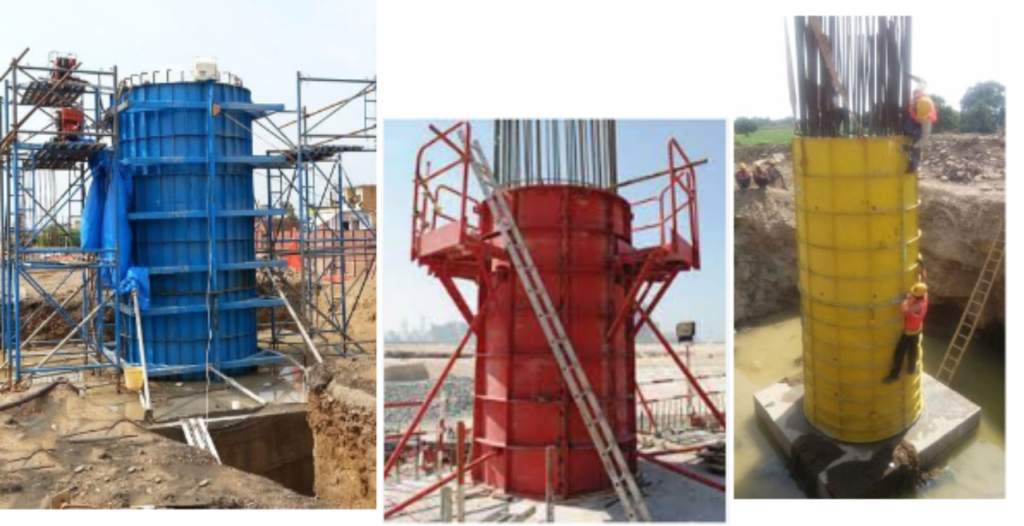CONSTRUCTIONS TECHNOLOGY & PRODUCTS
Pier & Supporting Structures
Formwork for Pier and Supporting Structures is a critical component in the construction of bridges, piers, and other infrastructure projects. In this detailed overview, we will discuss the key aspects of formwork for pier and supporting structures, including its working principles, advantages, disadvantages, applications, materials of construction (MOC), and provide a summary. |
| 1. Working Principles: Formwork for pier and supporting structures operates on fundamental principles shared with general formwork for concrete structures: |
| Support: Formwork supports the weight of freshly poured concrete until it cures and reaches sufficient strength to stand on its own. |
| Shape and Alignment: It defines the specific shape and alignment required for the pier and supporting elements, ensuring accuracy in construction. |
| Surface Finish: Formwork can also influence the surface finish of the concrete, whether it needs to be smooth, textured, or any other desired finish. |
| Removal: Once the concrete has cured to the required strength, the formwork is carefully removed, revealing the finished pier and supporting structures. |
| Formwork for Pier and Supporting Structures is a critical component in the construction of bridges, piers, and other infrastructure projects. It provides the necessary framework and mold to shape and support concrete until it cures and achieves the required strength. In this detailed overview, we will discuss the key aspects of formwork for pier and supporting structures, including its working principles, advantages, disadvantages, applications, materials of construction (MOC), and provide a summary. |
| 1. Working Principles: Formwork for pier and supporting structures operates on fundamental principles shared with general formwork for concrete structures: |
| Support: Formwork supports the weight of freshly poured concrete until it cures and reaches sufficient strength to stand on its own. |
| Shape and Alignment: It defines the specific shape and alignment required for the pier and supporting elements, ensuring accuracy in construction. |
| Surface Finish: Formwork can also influence the surface finish of the concrete, whether it needs to be smooth, textured, or any other desired finish. |
| Removal: Once the concrete has cured to the required strength, the formwork is carefully removed, revealing the finished pier and supporting structures. |

| 2. Advantages: |
| Customization: Formwork can be tailored to accommodate various pier and supporting structure designs, meeting specific project requirements. |
| Efficiency: It expedites construction by enabling the rapid placement of concrete, reducing labor and time. |
| Quality Control: Formwork ensures precision in construction, resulting in accurate dimensions and surface finishes for the pier and supporting elements. |
| Cost-Effective: Properly designed formwork can be reused across multiple projects, reducing material and labor costs over time. |
| Safety: Formwork provides a safe working platform for construction workers during concrete placement, enhancing overall project safety. |
| 3. Disadvantages: |
| Initial Cost: Fabricating or purchasing formwork can be expensive, especially for complex or large-scale projects. |
| Labor-Intensive: Assembling, installing, and removing formwork can be labor-intensive, impacting project schedules. |
| Maintenance: Formwork requires regular maintenance to ensure it remains in good condition for reuse. |
| Environmental Impact: Disposable formwork materials can contribute to construction waste, whereas reusable materials may have a higher environmental impact due to production. |

| 4. Applications: Formwork for pier and supporting structures is primarily used in the construction of bridges, piers, and similar infrastructure projects. It is specifically applied to create the following components: |
| Pier Shafts or Columns: These vertical components support the bridge superstructure and distribute loads to the foundation. |
| Abutments: Abutments support the ends of bridge superstructures and transfer loads to the ground. |
| Retaining Walls: In some cases, retaining walls may be considered as part of the supporting structure to address terrain and water flow. |
| 5. Materials of Construction (MOC): Materials used for formwork for pier and supporting structures can vary based on project requirements, but common materials include: |
| Timber: Traditional timber formwork is often used for smaller projects and is relatively cost-effective. |
| Plywood: Plywood is commonly used to face the formwork due to its smooth surface finish and durability. |
| Steel: Steel formwork is durable and can be reused multiple times. It is often used for larger and more complex projects. |
| Aluminum: Aluminum formwork is lightweight, corrosion-resistant, and reusable, making it suitable for high-rise construction and mass housing projects. |
| 6. Summary: Formwork for pier and supporting structures is an essential component in the construction of bridges, piers, and infrastructure projects. It serves as a mold and support structure for concrete, ensuring the accurate shaping, alignment, and curing of the material. Despite initial costs and labor-intensive aspects, formwork offers significant advantages, including customization, efficiency, quality control, cost-effectiveness, and safety. It plays a crucial role in achieving precise dimensions and surface finishes in pier and supporting structures. Formwork materials, whether timber, plywood, steel, or aluminum, are selected based on project requirements. Proper design, installation, and maintenance are vital for successful formwork usage in construction projects. |


 Sales & Marketing:
Sales & Marketing:  Service Supports:
Service Supports:  Website:
Website: 